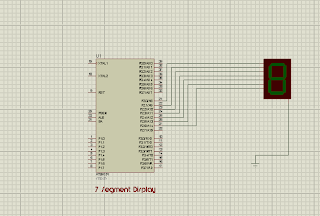This circuit shows how to obtain a 5V dc from a 240V ac supply (50Hz). The 7805 is used to regulate the rectified output (the four diodes form the full bridge rectifier) to obtain a voltage of 5V. A voltage of 12V or 9V can also be obtained using 7812 and 7809 respectively.
GENERATING A SQUARE WAVE USING 8051
Description: Generating a square wave using Timer0
for 8051 microcontroller
Written by: Victor
*/
#include <reg51.h>
sbit pin = P2^0;
sbit pin2 = P2^1;
void T0Delay(void);
void main()
{
P1 = 0x00; //initialize port 1
pin = 0;
while(1) //loop forever
{
pin = 1;
T0Delay(); //Timer0 is used to generate delay
pin = 0;
T0Delay();
}
}
void T0Delay()
{
TMOD = 0x01; //timer0 mode 1
TH0 = 0xDB;
TL0 = 0xFE;
TR0 = 1; //enable timer0 run bit
while(TF0 == 0); //wait here while flag remains 0
TR0 = 0;
TF0 = 0;
}
Output
7-SEGMENT DISPLAY USING 8051
/*
Description: The code is just a practice work, when a button
is pressed, an led lights up, the 7-segment display indicates
the number of leds that lite up
Written by: Victor
Note: The code could be modified and length reduced to
reduce the amount of ram consumed
*/
#include <reg51.h>
#define leds P2
#define segment P3
sbit button1 = P1^0;
sbit button2 = P1^1;
sbit button3 = P1^2;
sbit button4 = P1^3;
sbit button5 = P1^4;
sbit button6 = P1^5;
sbit button7 = P1^6;
void Delay(void);
unsigned char display[] = {0x3F,0x06,0x5B,0x4F,0x66,0x6D,0x7D,0x07,0x7F,0x6F}; // display no between 0-9
unsigned char j = 0; //initialize
void main()
{
segment = 0x00; //initialize
leds = 0x00;
if(button1 == 0) //loop forever
{
leds = 0x01;
segment = display[1]; //output the numbers
Delay(); //Delay for one second
}
else if(button2 == 0)
{
leds = 0x24;
segment = display[2]; //output the numbers
Delay(); //Delay for one second
}
else if(button3 == 0)
{
leds = 0x25;
segment = display[3]; //output the numbers
Delay(); //Delay for one second
}
else if(button4 == 0)
{
leds = 0x5A;
segment = display[4]; //output the numbers
Delay(); //Delay for one second
}
else if(button5 == 0)
{
leds = 0x5B;
segment = display[5]; //output the numbers
Delay(); //Delay for one second
}
else if(button6 == 0)
{
leds = 0x7E;
segment = display[6]; //output the numbers
Delay(); //Delay for one second
}
else if(button7 == 0)
{
leds = 0x7F;
segment = display[7]; //output the numbers
Delay(); //Delay for one second
}
}
void Delay(void)
{
unsigned int x;
for(x=0;x<33000;x++);
}
/*
This display numbers 0-9 on a 7-segment
display
Written by: Victor
*/
#include <reg51.h>
#define segment P2 // Assign identifier (segment) to Port 2
void Delay(void);
unsigned char display[] = {0x3F,0x06,0x5B,0x4F,0x66,0x6D,0x7D,0x07,0x7F,0x6F};
unsigned char j = 0; //initialize
void main()
{
segment = 0x00; //initialize
while(1) //loop forever
{
segment = display[j]; //output the numbers
Delay(); //Delay for one second
j++; //increment by 1;
if(j > 9) j = 0;
}
}
void Delay(void)
{
unsigned int x;
for(x=0; x<33000; x++); //one second delay loop
}
CHASING LED PROGRAMMING IN C USING KEIL UVISION FOR 8051
/*
Description: Eight Leds are connected to Port of the 8051
microcontroller, an led lights up, delays for about 1 sec
switches off, and the next led switches on, the loop repeats
itself forever
Written by: Victor
*/
#include <reg51.h>
#define LEDS P2
void Delay_ms(unsigned int);
void main()
{
unsigned char j = 1; // initialize value for j
while(1)
{
LEDS = j; // assign the value for j to P2
Delay_ms(100); //Delay about 1 sec...not too accurate though
j = j << 1; // shift value left
if(j == 0) j = 1; //if value exceeds 128 (decimal) initialize j
}
}
void Delay_ms(unsigned int itime)
{
unsigned int i,x;
for(i = 0;i<itime;i++)
for(x=0; x<1275; x++);
}
6V CONSTANT VOLTAGE CHARGER
This is a 6v constant voltage charger, the source is a solar panel (12V), LM317 is used as the adjustable voltage regulator, and the potentiometer is used in regulating the output voltage.






